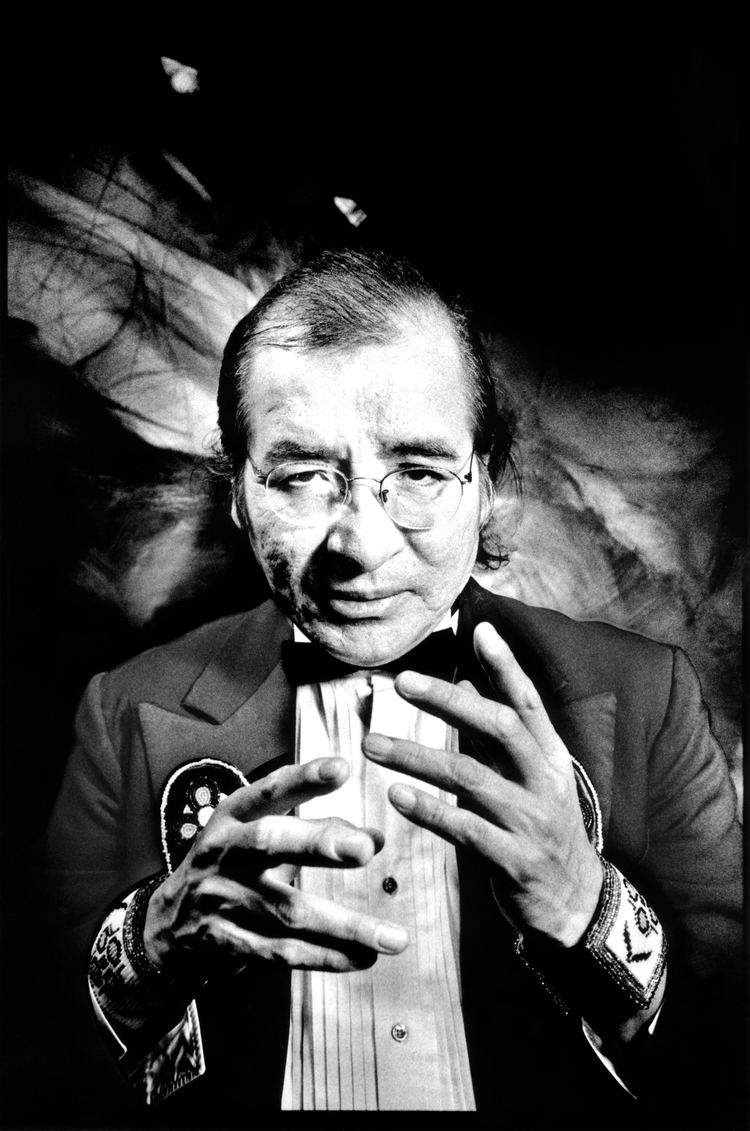Tomson Highway is the proud son of legendary caribou hunter and world championship dogsled racer, Joe Highway, and artist-in-her-own-right (as bead-worker and quilt-maker extraordinaire), Pelagie Highway. A full-blood Cree, he is a registered member of the Barren Lands First Nation, the village for which is called Brochet (pronounced “Bro-shay”) and which village is located in northern Manitoba where it meets Saskatchewan and what is now called Nunavut. Today, he writes novels, plays, and music for a living. Having studied music and English literature at the Universities of Manitoba (Winnipeg) and Western Ontario (London), as well as in England, he earned both his Bachelor of Music Honours (Piano Performance major, 1975) and the equivalent of a Bachelor of Arts (English major, 1976), both from “Western.”
Subsequently, for seven years, he immersed himself in the field of Native social work, working with children (and parents) from broken families, with inmates in prisons, with cultural-educational programmes of one kind or another, with other Native social workers and activists, with Native visual artists, writers, healers, Elders, politicians, women, 2-Spirits, etc. For all this, he worked on reserves and in urban centres across Ontario and, later on, Canada, though he was based almost always at head offices in Toronto. Then he turned 30 and decided it was time to put all this extraordinary artistic training and this extraordinary Native social work experience together – he started writing music, plays, and, later, novels.
After many years working in the Toronto theatre industry (and after many plays all of which he both wrote and produced himself), he achieved national (and international) recognition in 1986 with his sixth play, the multi-award-winning (and since cult-status/legendary) “THE REZ SISTERS.” This was followed in 1989 by its companion play, the even more successful “DRY LIPS OUGHTA MOVE TO KAPUSKASING,” which not only was nominated for and won numerous awards but was the first Canadian play in the history of Canadian theatre ever to receive a full production and extended run at Toronto’s legendary Royal Alexandra Theatre (1990). In fact, these two plays continue to be produced and/or studied at theatres and universities around the world, including theatres in such centres as New York City (Off-Broadway), Tokyo (in Japanese), Edinburgh, Scotland (the Edinburgh Festival), etc. As well, both have the distinction of being published in anthologies beside works written by such figures of world dramatic literature as Thornton Wilder, Tennessee Williams, Harold Pinter, and Bertold Brecht. Other plays/shows of many that he has written both before and after the above-named two are, “THE SAGE, THE DANCER, AND THE FOOL,” “ARIA,” “NEW SONG…NEW DANCE,” “ANNIE AND THE OLD ONE,” “A RIDICULOUS SPECTACLE IN ONE ACT,” “THE INCREDIBLE ADVENTURES OF MARY JANE MOSQUITO” (a one-woman cabaret/musical for young audiences), “A TRICKSTER TALE,” and “ROSE” (also a musical, though this one for audiences of all ages, features many characters, is, like “DRY LIPS…,” a companion piece to the afore-mentioned “THE REZ SISTERS,” and is, in fact, the third instalment in a planned seven-play cycle all based on the same set of characters, themes, and settings). Most recent (though not part of what he calls “The Rez Cycle”) is his tragi-comic allegory, “ERNESTINE SHUSWAP GETS HER TROUT” which had its world premiere at the Western Canada Theatre in Kamloops, B.C., 24 January, 2004 and has since played several other Canadian and American cities.
From 1986 to 1992, he was Artistic Director of Native Earth Performing Arts, Toronto’s only (at the time) professional Native theatre company and (also at the time) virtually Canada’s only such organization, out of which, over the years, have emerged not only some of Canada’s most accomplished and celebrated Native theatre and film artists but, as well, other professional Native theatre companies. In fact, in large part as a result of the work done at that company in that city at that time (not only by Mr. Highway but by innumerable other good, kind, generous, dedicated, and tireless folk, both Native and non-native), Canada, and Toronto in particular, now boasts the world’s most active and richest (in the cultural sense) Aboriginal theatre industry. We, that is to say, invented, from scratch, together, the term (and the concept), “Native show biz!” Even more important, however, is the fact that this groundwork gave birth to a nation-wide Native literary movement, a movement which, to this day, continues to play a fundamental role in the advancement of Aboriginal literacy and education right across the country. In part as a result of the production of a “national literature” that did not exist before those years, Native enrolment in Canada’s universities, just in the past decade-and-a-half alone, has sky-rocketed. In fact, it is becoming an increasingly normal feature of Canadian life to see talented young Native people earning Ph.D.’s in numbers unprecedented when as recently as ten years ago, such accomplishments were practically unheard of, when as recently as thirty years ago, very few Natives, in the north especially, stayed in school long enough even to earn their high school diploma.
In 1998, he published his first novel, “KISS OF THE FUR QUEEN,” which, like his plays, was nominated for several awards and, moreover, spent several weeks on Canadian bestseller lists. To this day, in fact, it continues to be absorbed into university curricula in many countries the whole world over, from Spain to Brazil, from Poland to New Zealand.
He has, as well, to his credit three children’s books, all published by HarperCollins Canada, in order: “CARIBOU SONG” (2001), “DRAGON FLY KITES” (2002), and “FOX ON THE ICE” (2003). All are written bilingually in Cree (his mother tongue).and English and are beautifully illustrated by Alberta-born, Toronto-based visual artist, Brian Deines (rhymes with “pines”). And, again, all three were short-listed for various prizes.
Among the many awards he has won are the Dora Mavor Moore Award for Best New Play and Best Production (three wins, five nominations), the Governor General’s Literary Award for Drama (two nominations), the Floyd S. Chalmers Canadian Play Award (two wins), the Toronto Arts Award (for outstanding contributions made over the years to the City of Toronto cultural industries, as winner, not as nominee), the Wang Harbourfront International Festival of Authors Award, the Silver Ticket Award (from the Dora Mavor Moore Awards, for outstanding contributions made over the years to the Toronto theatre industry), the National Aboriginal Achievement Award (2001), the Order of Canada (1994), and others too embarrassingly numerous to list. In fact, at one point in his life, his trophy case collapsed from the terrible weight and killed three people.
He holds ten honorary doctorates, these from Carleton University (Ottawa), Thornloe University (Sudbury), Brandon University, the University of Winnipeg, the University of Western Ontario (London), the University of Windsor, Laurentian University (Sudbury, Ontario), Lakehead University (Thunder Bay, Ontario), l’Universite de Montreal, and the University of Toronto. In addition, he holds two “equivalents” of such honours: from The Royal Conservatory of Music in Toronto and The National Theatre School in Montreal.
He has been Writer-in-Residence at the Universities of Toronto, Concordia (Montreal), British Columbia (Vancouver), and Simon Fraser University (at its Kamloops campus), among many others. As well, he has taught Aboriginal Mythology at the University of Toronto (University College), at which institution he holds the post of “Adjunct Professor” (meaning that he teaches there if and when he happens to be “in town,” a period of time that averages out to perhaps one month a year). Most recently, for the fall terms of both 2006 and 2007, he held the post of “Stanley Knowles Distinguished Visiting Professor” at Brandon University in Brandon, Manitoba.
He has criss-crossed North America, Europe, and the world with his readings, lectures, performances (at the piano), and teaching engagements at universities, colleges, schools, theatres, nightclubs, concert halls, bookstores, art galleries, and other institutions. In fact, as a world traveller (his hobby – born a nomad, always a nomad), he has, to date, circumnavigated the globe three times. And been to 55 countries (and counting…).
Several film and television documentaries on both his work and his background have been produced for the international market over the years, most notable among them being, “Adrienne Clarkson Presents,” “Life and Times” (respectively 1991 and 1997, both for the CBC), and, most recently, “Tomson Highway Gets His Trout” (2003, Getaway Films Inc.).
He speaks fluent Cree (his mother tongue), French, and English, though his Spanish is fast catching up. As well, having been trained by extraordinary teachers as a classical musician, he plays the piano “fluently.” In fact, he enjoys, as often as he can, combining his many lectures and readings around the world with performances at the piano, both solo and with singer/musician friends and colleagues (when available), mostly all with songs that he himself has written (both music and lyrics) over the years for his own shows, his own cabarets, his own “musicals.” Many of these songs, in fact, are written with Cree lyrics — Cree jazz? Cree cabaret? Cree Kurt Weill? Come and see them! Last, on the subject of language, his work, to date, has been translated into eleven languages.
He was born the 11th of 12 children on the 6th of December, 1951 in a snow bank. That is to say, he was born in a tent pitched in a snow bank (in one awful hurry!) on an island in a lake in the remotest reaches of northwestern Manitoba where it meets the Northwest Territories, Saskatchewan and what, since 1999, has been called Nunavut. His caribou-hunting family traversing the tundra, as always in those days, by dogsled, this lake – called Maria (pronounced “Ma-rye-ah”) – is situated some 200 kilometres north of the Indian reserve (Barren Lands) to which he belongs, the village for which is called Brochet (“Bro-shay”). He grew up NOT on the reserve, however, but rather in the spectacularly beautiful natural landscape that is Canada’s sub-Arctic, an un-peopled region of hundreds of lakes, endless forests of spruce and pine, and great herds of caribou. Today (as for the past eleven years), he divides his year equally between, in summer, a cottage on a lake in the heart of Ojibway (and French) Ontario just south of Sudbury (from whence hails his partner of 29 years) and, in winter, Gatineau Québec. At both of these locales — i.e. Canada and France — he is currently hard at work on his second and, as yet, untitled novel.
He thanks anyone and everyone for what, so far, has been an extraordinary “journey,” a magic carpet ride of the very first order.

